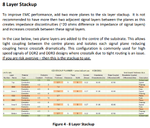engr_joni_ee
Advanced Member level 3

Hi,
I am going to design with 8 layers having LVDS 450 MHz traces. I am just wondering about the Stack-up scheme. How about the following arrangement of layers.
Layer 1 : Routing
Layer 2 : Routing/Ground
Layer 3 : Ground
Layer 4 : Power
Layer 5 : Power
Layer 6 : Routing/Ground
Layer 7: Ground
Layer 8: Routing
Is it necessary to have one ground plane between two power planes or not ? Any comments on the above layer arrangement ?
I am going to design with 8 layers having LVDS 450 MHz traces. I am just wondering about the Stack-up scheme. How about the following arrangement of layers.
Layer 1 : Routing
Layer 2 : Routing/Ground
Layer 3 : Ground
Layer 4 : Power
Layer 5 : Power
Layer 6 : Routing/Ground
Layer 7: Ground
Layer 8: Routing
Is it necessary to have one ground plane between two power planes or not ? Any comments on the above layer arrangement ?




